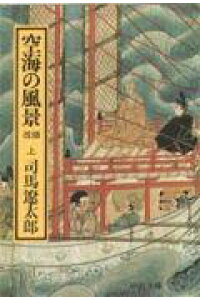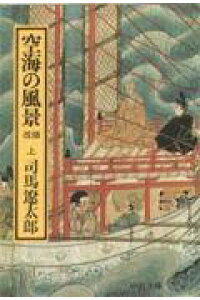司馬遼太郎 著「空海の風景 上巻」 中公文庫
空海に興味を持ち、何冊か読んでみた中の1冊です。司馬さんは当然、細かく取材されているので、参考となる情報がいくつかありました。別途、真偽について調査もしましたが、おおむね正しいと思われます。やはり、小説家なので文章は上手く、記憶に残りやすいです。
遣唐使について、如何に我々の先祖の航海術が出鱈目であったかが描かれています。まず、航海に重要な風の向きについて、いくつか引用してみます。「夏には風は唐から日本へ吹いている。が、五島から東シナ航路をとる遣唐使船は、6,7月という真夏を選ぶ。」別の資料によると、唐の宮廷での新年の祝賀への出席を目指していたので、この頃に出発となったようです。
その結果、「逆風に遭遇すれば船は覆らざるをえないのだが、ほとんど迷信のように真夏をえらび、しばしば遭難した。秋になれば、風は日本から唐土に吹き、この航路にとって順風になる。その簡単な事実に気づかず、何度も遭難をかさね」たそうです。
次に、航海で重要な方角の見定め方について引用すると、「天測して方角を知るという航海法は、西方の海洋民族はすでに知っていたが、空海のころのこの国の航海者はそれを知らなかった。」その結果、「国家はどの遣唐使船にも陰陽師と卜部(うらべ)を乗船させていた。方角の見定めは占卜(せんぼく)に頼った。」
まじない、占いに頼るのは、致し方ないとは言え、本当にどれくらいの数の人が信じていたのか、聞いてみたくなります。
「かれらは星影を測るための鉄尺、銅製の律管などの道具を持って船に乗り込んでいたが、星の位置を測りはしてもそこから導きだされてくる判断は吉凶を論ずる神秘論であった。」
「夜になると、舳に卜部の者が、田の中の鶴のように、すねをのばして突っ立つ。星や卜筮(ぼくぜい)でうらなってから、 ――――この方向で良い。吉である。といったふうに決めて行くのである。」
これでは、生還率50%も無理はないですね。ちなみに空海は東シナ海を横断するのに34日かかったそうです。一方、同じ船団で別の船で出発した最澄は50日以上かかっています。これはほとんど遭難です。本当に命懸けの航海でした。(完)

価格:754円
(2021/6/1 16:12時点)
感想(11件)
Kukai’s Landscape, Volume 1 (English)
Ryotaro Shiba, “Kukai’s Landscape, Vol. 1”, Chuko Bunko
This is one of the several books I read because of my interest in Kukai. Mr. Shiba has naturally covered the subject in detail, so I found some information that was helpful. I also did a separate research on the authenticity of the book, and it seems to be generally correct. As I said, he was a novelist, so his writing was good and memorable.
This article describes how our ancestors’ navigation skills were haphazard. First of all, let me quote a few words about the direction of the wind, which is important for navigation. “In summer, the wind blows from the Tang Dynasty to Japan, but the envoys from Gotō islands to East China choose the midsummer months of June and July. According to another source, the envoy was aiming to attend the New Year’s celebration at the Tang court, so they left Japan around this time to arrive in the capital of Tang Dynasty before New Year.
As a result, he said, “If the ship encounters a headwind, it will be forced to turn over, but almost as if by superstition, it chose midsummer and was often lost. In the fall, the wind blows from Japan to the Tang Dynasty, making it a favorable wind for this route. They did not realize this simple fact and got lost many times.
Next, I would like to quote the important method of determining the direction of voyage: “The western maritime peoples already knew how to determine the direction by measuring the heavens, but the navigators of this country at the time of Kukai did not know it. As a result, “the nation had Onmyoji and Urabe (Fortune Tellers) aboard every envoy’s ship. They relied on fortune-telling to determine the direction.”
Even though we can’t help but rely on spells and fortune telling, I would like to ask how many people really believed in them.
“They came on board with tools to measure the shadows of the stars, such as an iron scale and a copper law pipe, but although they measured the positions of the stars, the judgments they drew from them were mystical theories of good and evil.”
When night falls, a diviner stands at the bow of a ship with his shins outstretched like a crane in a field. After reading the stars and divination sticks, he would say, “This is a good direction. It is good luck. This is a good direction to go.”
With this, it was no wonder that the survival rate was 50%. Incidentally, it took Kukai 34 days to cross the East China Sea. On the other hand, it took over 50 days for Saicho, who set out on a different ship in the same fleet. This was almost like being lost. It was truly a voyage of risking one’s life. (End)
Le Paysage de Kukai, tome 1 (Français)
Ryotaro Shiba, “Paysage de Kukai, Vol. 1”, Chuko Bunko
C’est l’un des nombreux livres que j’ai lus en raison de mon intérêt pour le Kukai. M. Shiba a naturellement couvert le sujet en détail, et j’ai donc trouvé des informations utiles. J’ai également effectué une recherche séparée sur l’authenticité du livre, et il semble qu’elle soit généralement correcte. Comme je l’ai dit, c’était un romancier, donc son écriture était bonne et mémorable.
Cet article décrit comment les compétences de nos ancêtres en matière de navigation étaient aléatoires. Tout d’abord, permettez-moi de citer quelques mots sur la direction du vent, qui est importante pour la navigation. “En été, le vent souffle de la dynastie Tang vers le Japon, mais les envoyés des îles Gotō vers la Chine orientale choisissent les mois de juin et juillet, en plein été. Selon une autre source, l’envoyé avait pour objectif d’assister à la célébration du Nouvel An à la cour des Tang, ils quittaient donc le Japon à cette époque pour arriver dans la capitale de la dynastie Tang avant le Nouvel An.
En conséquence, il a déclaré : “Si le navire rencontre un vent contraire, il sera obligé de se retourner, mais presque comme par superstition, il a choisi le milieu de l’été et a souvent été perdu. En automne, le vent souffle du Japon vers la dynastie Tang, ce qui en fait un vent favorable pour cette route. Ils n’ont pas réalisé ce simple fait et se sont perdus de nombreuses fois.
Ensuite, je voudrais citer l’importante méthode de détermination de la direction du voyage : “Les peuples maritimes occidentaux savaient déjà comment déterminer la direction en mesurant les cieux, mais les navigateurs de ce pays à l’époque de Kukai ne le savaient pas. Par conséquent, “la nation avait des Onmyoji et des Urabe (diseurs de bonne aventure) à bord de chaque navire d’envoyés. Ils se fiaient à la voyance pour déterminer la direction.”
Même si l’on ne peut s’empêcher de se fier aux sorts et à la voyance, je voudrais demander combien de personnes y croyaient vraiment.
“Ils sont venus à bord avec des outils pour mesurer les ombres des étoiles, comme une balance en fer et un tuyau de loi en cuivre, mais bien qu’ils aient mesuré les positions des étoiles, les jugements qu’ils en ont tirés étaient des théories mystiques du bien et du mal.”
À la nuit tombée, un devin se tient à la proue d’un navire, les tibias tendus comme une grue dans un champ. Après avoir lu les étoiles et les bâtons de divination, il dit : “C’est une bonne direction. C’est une bonne chance. C’est une bonne direction à prendre.”
Avec ça, il n’est pas étonnant que le taux de survie soit de 50%. Incidemment, il a fallu 34 jours à Kukai pour traverser la mer de Chine orientale. En revanche, il a fallu plus de 50 jours à Saicho, qui est parti sur un autre navire de la même flotte. C’était presque comme être perdu. C’était vraiment un voyage où l’on risquait sa vie. (Fin)
